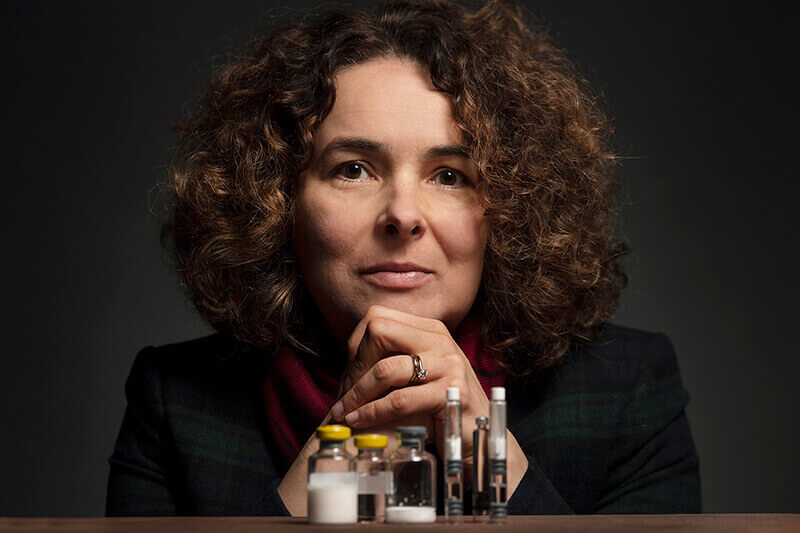April 2, 2019
Because there are no pharmacies in space
Lyophilization can help create food for space travel, new medicines for cancer
WEST LAFAYETTE, Ind. — Research continues on an eventual 140-million-mile mission to Mars, developing the latest transportation as well as habitats necessary for the red planet.
 Alina Alexeenko, a professor of aeronautics and astronautics, is founding co-director of the Advanced Lyophilization Technology Hub and is researching the process, also called freeze drying, and its possible uses in space and pharmaceuticals. (Purdue University photo/Rebecca Wilcox)
Download image
Alina Alexeenko, a professor of aeronautics and astronautics, is founding co-director of the Advanced Lyophilization Technology Hub and is researching the process, also called freeze drying, and its possible uses in space and pharmaceuticals. (Purdue University photo/Rebecca Wilcox)
Download image
But embarking on such a mission and safely living both during and afterward are differing ideas. The latter is the research focus of Alina Alexeenko.
“We know how to get to space, but that’s not the same as knowing how to survive there,” said Alexeenko, a Purdue professor in aeronautics and astronautics. “If we are to do a colony on Mars, we’re not going to send pills or a pharmaceutical factory. There won’t be a CVS on Mars.”
To make sure astronauts have the nourishment and medication to survive such a yearlong venture into space, Alexeenko has taken on several research projects involving lyophilization, also called freeze drying.
Lyophilization uses a sterile, vacuum environment to remove water from products such as food and medicine after they are frozen. The process converts the frozen moisture in the items to a vapor, eliminating the liquid phase.
The results increase the stability and shelf life of medication and improve the ability to store and transport food while keeping its nutritional value. Lyophilization is used in almost half of biopharmaceutical medications created.
“If we are to do a colony on Mars, we’re not going to send finished pills or a pharmaceutical factory,” Alexeenko said. “We have to reinvent how medicines will be stored and carried and lyophilization will be involved because we will need to preserve medicines long term.”
Alexeenko is founding co-director of the Advanced Lyophilization Technology Hub, or LyoHub, based in the Birck Nanotechnology Center at Purdue’s Discovery Park. She is joined by Elizabeth Topp, fellow founding co-director and a professor of industrial and physical pharmacy.
Food and medicine aren’t the only items that can be submitted to lyophilization. Alexeenko said a biological water treatment system for space stations and space colonies focuses on keeping bacteria alive in a freeze-dried state. The bacteria can then be used to treat the water.
“I think it’s the least known of the most important technologies invented in the 20th century,” she said. “If you look at the impact, it’s quite significant. There are so many aspects of it beyond space, such as manufacturing and technology.”
So unknown, in fact, that Alexeenko herself says it was by chance that she began her work in lyophilization. As a second-year assistant professor in 2007, Alexeenko got an email from an engineer from the Netherlands asking about an unusual state of gases he said encountered in lyophilization. She asked a colleague next door if he ever heard about such technology and he pointed her toward a friend in the College of Pharmacy.
Pharmaceuticals are a big recipient of the benefits of freeze drying. It was first used to stabilize blood plasma to treat childhood infections before vaccines were available and later allowed the use of blood banks during World War II and soon after allowed the mass production of penicillin. It is now part of the process for many new anti-cancer and anti-rheumatoid arthritis medicine and many vaccines.
Lyophilization research focuses more on the process itself compared with how it can be used. New control methods and sensors are improving a less-than-efficient process that Alexeenko compared to making cookies in an oven, one batch at a time.
“You have the recipe, but you don’t necessarily know what’s going on until it’s done and you pull them out,” she said. “But sensors can provide information in real time and controls can keep the process within a range that safe for the molecule that are impacted.”
Purdue’s LyoHub is made up of a consortium of more than 20 industry leaders in food medicine and other areas. Alexeenko said one of the projects has developed a numerical simulation for understanding probability of lyophilization, allowing for a computer test rather than a costly experimental run.
The industry-university partnership also has produced a first technology road map in lyophilization and is working on the first set of science-based standards for the technology.
“Because it’s done in a vacuum, it takes a lot of energy and can be difficult,” Alexeenko said. “It’s a very complex manufacturing process with a lot of physics that are very intricate.
“There is a lot of room for improvement,” she said. “It’s a fairly low efficiency technology. I want to see, in my professional career, the process made much faster and continuous.”
Alexeenko’s research aligns with two themes of Purdue’s Giant Leaps celebration, “Space: Earth, Exploration, Economics,” and “Health, Longevity and Quality of Life,” acknowledging the university’s global advancements made as part of Purdue’s 150th anniversary. They are two of the four themes of the yearlong celebration’s Ideas Festival, designed to showcase Purdue as an intellectual center solving real-world issues.
Writer: Brian Huchel, 765-494-2084, bhuchel@purdue.edu
Source: Alina Alexeenko, 765-496-1864, alexeenk@purdue.edu

